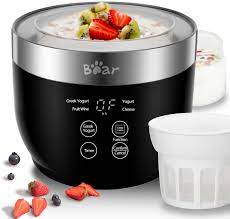Yogurt is cultured milk. It is made by heating milk and combining it with two live cultures—Lactobacillus bulgaricus and Streptococcus thermophilus. The warm milk creates the perfect environment for the bacteria to grow, thickening the milk to create yogurt.
The word “yogurt” comes from the Turkish “yogurmak ,” which means “to thicken.” It was first made, accidentally, by herders in Central Asia several thousand years ago. They used sheep stomachs to store their milk. The bacteria from the stomach lining thickened the milk into yogurt.
During my research, I found that like most things, there are a million different ways to make homemade yogurt. You can order a starter or use a commercial yogurt as your starter. You can use a dehydrator, heating pad, crockpot, yogurt maker, or oven to act as your incubator.
You’ll need a thermos flask to keep your milk nice and cosy while the bacteria does its job turning it into yoghurt. A wide-mouthed flask is best. If you don’t have a thermos, use a heavy pot with a lid, and keeping it somewhere insulated and warm – an oven set at a very low temperature would work. You’ll also need a pan to heat the milk, a spoon or fork and some jars to store your finished batch.
Step 1: Choosing Your Milk
Heat 2 pints (1.1 litres) of full-fat milk over a medium-low heat until almost bubbling (85ºC), stirring often so it doesn’t catch on the bottom. Leave it to cool so you can stick your finger in it but it’s still pretty hot (46ºC). If you want to get specific with this, use a thermometer.
Step 2: Heating the milk
Put your milk in a stainless steel pan on the stove and heat over medium heat until it reaches 180°F. The first time I made my yogurt I only had a basic candy thermometer, so I had to really stay with it to watch the temperature.
Step 3: Cooling the milk
Put your milk in a stainless steel pan on the stove and heat over medium heat until it reaches 180°F. The first time I made my yogurt I only had a basic candy thermometer, so I had to really stay with it to watch the temperature.
Step 4: Adding the Culture
Once the milk has reached 115°F, you will add 2 tablespoons of pre-made yogurt to each quart of milk. The yogurt can come from either a previous batch (if you’ve already made some) or from store-bought yogurt. You can also use a store-bought yogurt culture, but using pre-made yogurt is easier and less expensive.
Step 5: Incubating the Yogurt
Once the culture has been added, it is ready to go into the oven to incubate (with the lids on). You want a fairly consistent temperature.
The yogurt needs to incubate for at least 10-12 hours. The GAPS protocol calls for a 24 hour incubation period in order for the majority of lactose to be consumed by the bacteria. The longer it incubates, the more tangy the finished yogurt will be.
Combine whole-milk yogurt with honey and your favorite flavorings, like peanut butter and bananas or frozen fruit. Blend together and place in the freezer.


